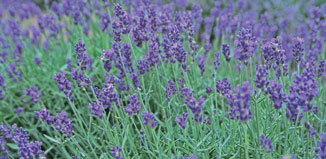When I fantasize about the garden of my dreams, I imagine azure fields of fragrant lavender, swathes of silvery-grey foliage nodding in the breeze.
These hardy Mediterranean shrubs are long-flowering, easy and trouble-free to grow when given conditions they enjoy – a sunny position and free-draining soil. They are useful, and look wonderful planted as border hedges, and as part of your pottager garden. Lavender looks spectacular casually spilling over a warm bank, but also rather special as a formal, standard topiary. Great in patio pots and tubs too, just remember to keep well-watered – in summer it could be as frequent as once a day.
Most lavender grown in home gardens come from either the spica, or the stoechas group.
The spica group includes the intensely fragrant English lavenders (lavendula angustifolia). The flowers retain their perfume, have high oil content, and are brilliant for pot pourri or scented sachets – just strip the flowers as they colour, and dry in a cool, shady place. Lavendula angustifolia is what you smell in your lavender-scented soaps, shampoos and candles.
Although they are great plants all year round – grey-green mounds, then soft grassy balls before they flower, their peak flowering time is in the heat of summer. This is the ideal lavender to plant for your small border hedge. “Munstead” is a good one to try – it is a compact plant, with violet-blue, long-stemmed flowers. The dwarf “Hidcote” has deep purple blossoms, and for something different, you could try the pinkish-white “Alba”.
Stoechas type lavenders can be recognised by “rabbit ear” bracts at the end of each flower spike. They include the most commonly grown French lavender (lavendula denata), Spanish or Italian lavender (lavendula stoechas) as well as many cultivars bred from these varieties. They don’t have the same intense fragrance as English lavender, but are certainly fragrant.
“Major” is one of the showiest of the stoechas types, with large, plump, dark blue flowers on short, strong stems. From mid-spring to early summer the easy to grow “Pukehou”, with its showy bracts and luminous wings, looks brilliant, particularly when planted en masse. It grows to form a tidy and dense bush, and will produce a second flush of flowers from late summer if the early spent flowers are clipped off.
If you want something a little taller, try “Avonview”. The deep violet flowers are produced on a bushy plant, which grows to eighty centimetres, with dense, bright green to grey foliage.
You can feed with a general garden fertiliser in spring, to enhance flowering, but lavender are not particularly hungry plants. Just keep trimming after each flower flush finishes. This keeps the plant bushy, and prevents that leggy, woody, rather billowy look.
You might get a few caterpillars, but bugs don’t seem to bother lavenders. Spittle bug is often found in early summer, but although it looks “yukky”, they cause no significant damage.

